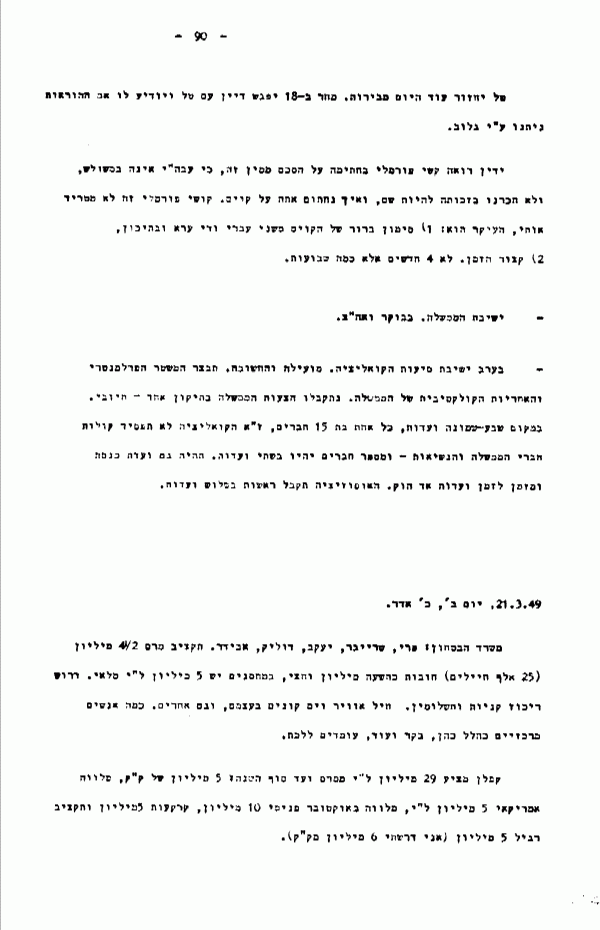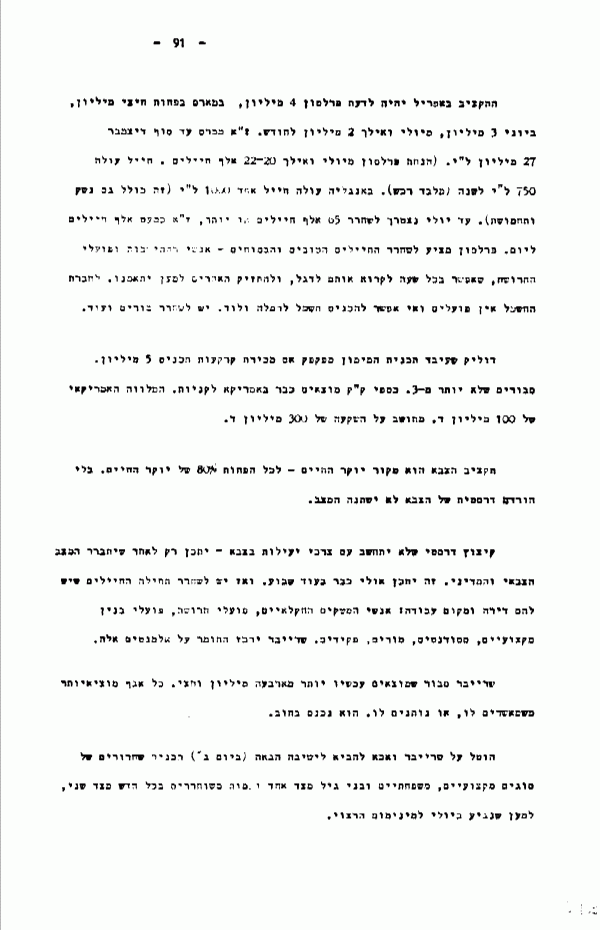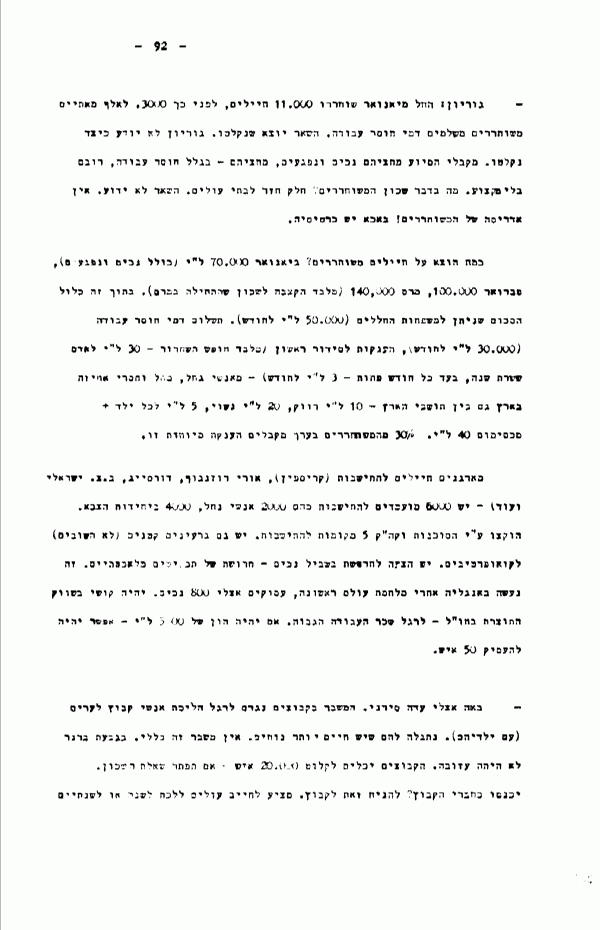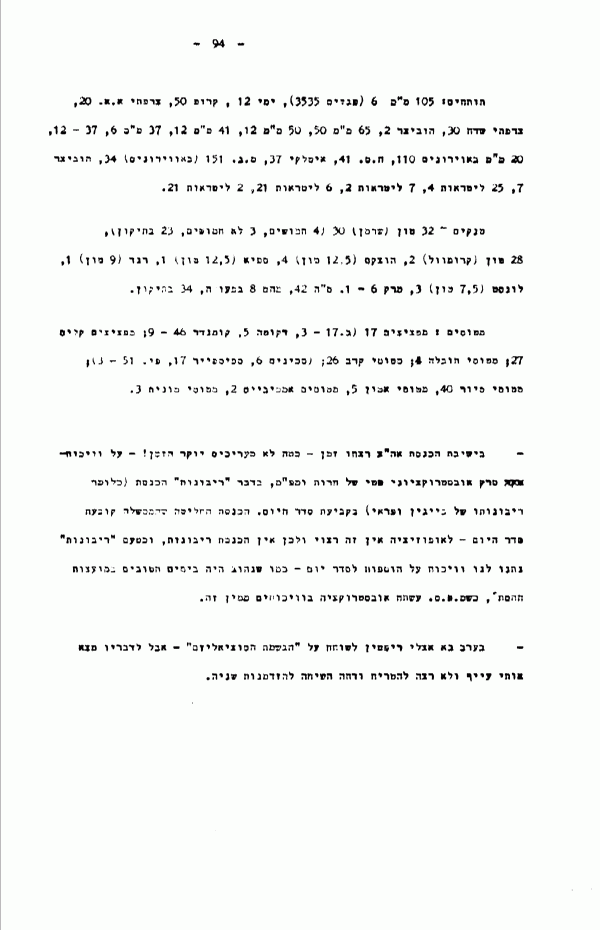Monday, March 21, 1949
Ministry of Defense: Peri, Schreiber, Ya'akov, Dolik, Avidar. The March budget is 4.5 million (25,000 soldiers), debts about 9.5 million, in the warehouses there's a stockpile of P£ 5 million. Need to centralize purchases and payments. The Air Force and Navy buy for themselves, and so do others. A few key figures such as Hillel Cohen, Becker, and others are about to leave.
Kaplan proposes P£ 29 million from March through the end of the year: 5 million from KK [KKL - Keren Kayemet LeIsrael, the Jewish National Fund], an American loan P£ 5 million, an internal loan in October 10 million, lands 5 million and regular budget 5 million (I demanded 6 million from KK).
In Perlson's view the April budget will be 4 million, in March half a million less, in June 3 million, from July onward 2 million per month. That means from March through the end of December P£ 27 million. (Perlson's assumption, from July onward 20-22,000 soldiers). A soldier costs P£ 750 per year (aside from procurement). In England one soldier costs P£ 1,000 (this also includes weapons and ammunition). By the end of July we'll need to discharge 65,000 soldiers or more, i.e. nearly a thousand soldiers per day. Perlson proposes discharging the good and reliable soldiers - settlement men and factory workers, who can be called up at any time, and to hold onto the others in order to train them. The electric company lacks workers and it isn't possible to install electricity in Ramle and Lod. Teachers and others need to be discharged.
Dolik, who prepared the funding plan, doubts that land sales will bring in 5 million. They think that no more than 3. KK funds are already in America for purchases. The American loan of $100 million is calculated on the basis of an investment of $300 million.
[In Dolik Horowitz's view] the military budget is the source of the cost of living - at least 80% of the cost of living. Without drastic reduction of the army the situation won't change.
Drastic cuts that don't take into account the army's efficacy needs will only be possible after the military and political situation becomes clear. This might be as soon as a week from now. And then the soldiers who have an apartment and a workplace should be discharged first: members of the agricultural settlements, industrial workers, professional construction workers, students, teachers, administrative workers. Schreiber will assemble the material on these elements.
Schreiber thinks that more than 4.5 million is being expended now. Each department spends more than is approved for it, or given to it. It goes into debt.
Schreiber and the Personnel Department were tasked with bringing to the next meeting (on Tuesday) a plan for [military] discharge by occupational, familial, and age categories on the one hand, and the number of discharged [soldiers] each month on the other hand, so that we reach the desired minimum by July.
- Gurion: Since January 11,000 soldiers have been released, before that 3,000. 1,200 discharged [soldiers] are receiving unemployment wages. The rest, it turns out, have been integrated. Gurion doesn't know how they've been integrated. Among aid recipients, half are disabled and wounded, half - because of unemployment, most of them lack an occupation. What about housing those discharged? Some returned to immigrants' homes. The rest, unknown. There's no address for those discharged! The Personnel Department keeps a record.
How much was spent on discharged soldiers? In January P£ 70,000 (including disabled and war-afflicted), February 100,000, March 140,000 (aside from an allocation for housing that began in March). This includes the sum paid to families of fallen soldiers (P£ 50,000 per month). Unemployment wages (P£ 30,000 per month), grants for initial arrangement (aside from discharge vacation - P£ 30 for whoever served a year, for each month less - P£ 3 per month) - among GAHAL [foreign recruitment], MAHAL [volunteers from abroad] personnel and those who don't have a foothold in the country as well as among residents of the country -P£ 10 unmarried, P£ 20 married, P£ 5 for each child + maximum P£ 40. About 30% of those discharged receive this special grant.
Soldiers are being organized for settlement (Krispin [sp.], Uri Rosenbuf [sp.], Dorseig [sp.], B. Z. Israeli and others) - there are 6,000 candidates for settlement, of whom 2,000 are NAHAL [No'ar Halutzi Lohem - Pioneer Fighting Youth, a combined military service and agricultural settlement program] members, 4,000 in army units. The [Jewish] Agency and KKL [the Jewish National Fund] have designated 5 places for settlement. There are also small (unimportant) gar'inim [core groups for settlement purposes] for cooperatives. There's an allocation for a factory for the disabled - a factory for artificial limbs [?]. This was done in England after World War I; 800 disabled people are employed here. It will be difficult to market the product abroad - in light of the high work wage. If there's capital of P£ 5,000 - it will be possible to employ 50 people.
- Ada Sereni came to see me. The crisis in the kibbutzim resulted from kibbutz members leaving for the cities (with their children). They discovered that it's a more comfortable life. This crisis is not universal. There was no exodus in Giv'at Brenner. The kibbutzim can receive 20,000 people - if the housing question is resolved. Will they join as kibbutz members? This should be up to the kibbutz. The suggestion is to allow immigrants to go to kibbutzim for a year or two - after that they'll leave, if they want to.
- Sherf: A delegation of war disabled abroad came to see me. There are about 400, of whom 150 are not organized, the rest were organized by the [Jewish] Agency.
- Shaul [Avigur] and Ben-Zion [Israeli]: Need to organize an "operation" over the course of two months to participate in settlement. People have been recruited for this. I told them that it's not enough to mobilize soldiers for settlement - settlement should be prepared for soldiers. I suggested that on Monday of next week Agency representatives convene, [Yosef] Weitz and others, with specific proposals for settlement - plots of land, budget, housing.
- Rabbi Fishman came to see me: The army rabbis want to quit. He's delaying. He wants me to meet with Goronczik [Goren]. I agreed of course. But he has other complaints: I'm not as favorably inclined towards him as I was in the past. He wants to resign from work. His health is deteriorating (ulcer, eyes), but he fears that his replacement will be bad for us and be more zealous than him.
- Armament status in March: rifles 47,744, Browning machine [gun]s 89, Hotchkiss 53, Besa 848, MG-34 machine guns 5,150, RKM [?] machine guns 134, [heavy] machine guns 132, Bren machine guns 820, Lewis machine guns 10.8, other caliber [heavy] machine [gun]s 703, French rifes 1,069, Sten machine guns 299, submachine guns (our production) 29,060, Thompson submachine guns 742, pistols 5,509, flare guns [?] 5,052, bayonets for Czech rifles 7,171, for English rifles 3,054, steel helmets 31,127 (in total: heavy machine guns 142, medium 1,683, [light] machine guns 6,551, rifles 60,719, submachine guns 29,802, bayonets 10,225).
Mortars: David 24, 60 mm 23, 3" 655, 2" 1506, Bazookas 18, M2 [?] 67, PIATS 1,223, anti-tank rifles 69, flamethrowers 293, Molotov cocktails 29,381, Mills grenades 171,874, firing pins [?] 9,815, attack 8,158, smoke 39,983.
Cannons: 105 mm 6 (shells 3,535), naval 12, Krupp 50, French A.A. [anti-air?] 20, French field 30, Howitzer 2, 65 mm 50, 50 mm 12, 41 mm 12, 37 mm 6, 37 - 12, 20 mm on planes 110, H.S. [?] 41, Italian 37, M.G. 151 (on planes) 34, Howitzer 7, 25-pounder 4, 7-pounder 2, 6-pounder 21, 2-pounder 21.
Tanks - 32 ton (Sherman) 30 (4 armed, 3 unarmed, 23 under repair), 28 ton (Cromwell) 2, Hotchkiss (12.5 ton) 4, Safi [? unclear] (12.5 ton), Rand [?] (9 ton) 1, Lancet [?] (7.5 ton) 3, Mark [?] 6 - 1. Total 42, of which 8 are in operation, 34 under repair.
Airplanes: bombers 17 (B17 - 3, Dakota 5, Commander 46 - 9; light bombers 27; cargo planes 4; fighter planes 26; (Knives [Messerschmitts] 6, Spitfire 17, P51 - 3); reconnaissance planes 40, training planes 5, amphibian planes 2, taxi planes 3.
- At the Knesset meeting in the afternoon they murdered time - how they fail to appreciate the preciousness of time! - on a pointless obstructionist debate by Herut and Mapam regarding the "sovereignty" of the Knesset (meaning the sovereignty of [Menachem] Begin and [Eliezer] Frei in setting the agenda). The Knesset decided that the government sets the agenda - it's not desirable that the opposition do this and therefore the Knesset is not sovereign, and as a taste of "sovereignty" they gave us a debate about addenda to the agenda - as was customary in the good days of the Histadrut council, when M.P.S. [the Communist Party] engaged in obstruction through arguments of this sort.
- In the evening Riptin came to see me to discuss "the actualization of socialism" - but according to him he saw that I was tired and didn't want to trouble me and postponed the conversation to another opportunity.













